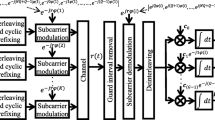Abstract
Different modulation schemes supporting multiple data rates in a Direct Sequence Code Division Multiple Access (DS-CDMA) system are studied. Both AWGN and multipath Rayleigh fading channels are considered. It is shown that the multi processing-gain scheme and the multi-channel scheme have almost the same performance. However, the multi-channel scheme may have some advantages due to easier code design and multiuser receiver construction. The drawback though, is the need for linear amplifiers also in mobile terminals. A multi-modulation scheme is also possible, but the performance for the users with the high data rates are significantly worse than for the other schemes. Furthermore multi chip-rate, parallel combinatory spread spectrum (PC/SS), pulse position modulation (PPM) and variable duty cycle schemes are discussed briefly.
Similar content being viewed by others
References
R.H. Katz, “Adaption and mobility in wireless information systems”, IEEE Personal Commun., Vol. 1, No.1, pp. 6–17, 1994.
TIA/EIA/IS-95, “Mobile stationbase station standard for dual-mode wideband spread spectrum cellular system”, Telecommunication Industry Association, July 1993.
T. Ottosson and A. Svensson, “Performance of different multirate schemes in DS/CDMA systems”, in Proc. NRS seminar on Radio communication networks, Linköping, Sweden, 1994, pp. 15–18.
T. Ottosson and A. Svensson, “Multirate schemes in DS/CDMA systems”, in Proc. IEEE VTC'95, Chicago, USA, 1995, pp. 1006–1010.
A. Baier, U.C. Fiebig, W. Granzow, P. Teder, and J. Thielecke, “Design study for a CDMA-based third-generation mobile radio system”, IEEE J. Select. Areas Commun., Vol. 12, No.4, pp. 733–743, 1994.
T.H. Wu and E. Geraniotis, “CDMA with multiple chip rates for multi-media communications”, in Proc. Information Science and Systems, Princeton University, 1994, pp. 992–997.
N. Doi, T. Yano, and N. Kobayashi, “DS/CDMA prototype system transmitting low bit-rate voice and high bit-rate ISDN signals”, in Proc. IEEE VTC'94, Stockholm, Sweden, 1994, pp. 51–55.
S. Tachikawa, “Modulation in spread spectrum communication systems”, IEICE Trans. Commun., Vol. E75B, No.6, pp. 445–452, 1992.
S. VerdÚ, “Minimum probability of error for asynchronous gaussian multiple-access channels”, IEEE Trans. Inform. Theory, Vol. IT-32, No.1, pp. 85–96, 1986.
E. Geraniotis and M.B. Pursley, “Error probability for direct-sequence spread-spectrum multiple-access communications - Part II: Approximations”, IEEE Trans. Commun., Vol. COM30, No.5, pp. 985–995, 1982.
E. Geraniotis and B. Ghaffari, “Performance of binary and quaternary direct-sequence spread-spectrum multiple-access systems with random signature sequences”, IEEE Trans. Commun., Vol. 39, No.5, pp. 713–724, 1991.
T. Ottosson and A. Svensson, “Multirate schemes in DS/CDMA systems”, Tech. Report No. 14, Dept. Information Theory, Chalmers University of Technology, Göteborg, Sweden, ISSN 0283–1260, 1995.
M.B. Pursley, “Performance evaluation for phase-coded spread-spectrum multiple-access communication - Part I: System analysis”, IEEE Trans. Commun., Vol. COM25, No.8, pp. 795–799, 1977.
S. Tachikawa, “Recent spreading codes for spread spectrum communication systems”, Electronics and Communications in Japan, Part I, Vol. 75, No.6, pp. 41–49, 1992.
D.W. Bennet, R.J. Wilkinson, and P.B. Kenington, “Determining the power rating of a multichannel linear amplifier”, IEE Proc.Commun., Vol. 142, No.4, pp. 274–280, 1995.
T. Eng and L.B. Milstein, “Comparison of hybrid FDMA/CDMA systems in frequency selective Rayleigh fading”, IEEE J. Select. Areas Commun., Vol. 12, No.5, pp. 938–951, 1994.
A. Jalali and P. Mermelstein, “Effects of diversity, power control, and bandwidth on the capacity of microcellular CDMA systems”, IEEE J. Select. Areas Commun., Vol. 12, No.5, pp. 952–961, 1994.
J. Zhu and G. Marubayashi, “Properties and application of parallel combinatory SS communication system”, in Proc. IEEE Int. Symposium on Spread Spectrum Techniques and Applications (ISSSTA'92), Yokohama, Japan, 1992, pp. 227–230.
S. Sasaki, J. Zhu, and G. Marubayashi, “Performance of the parallel combinatory spread spectrum multiple access communication system with error control technique”, in Proc. IEEE Int. Symposium on Spread Spectrum Techniques and Applications (ISSSTA'92), Yokohama, Japan, 1992, pp. 159–162.
I. Okazaki and T. Hasegawa, “Spread spectrum pulse positionmodulation - A simple approach for Shannon's limit”, IEICE Trans. Commun., Vol. E76-B, No.8, pp. 929–940, 1993.
M. Kavehrad and P.J. McLane, “Performance of low-complexity channel coding and diversity for spread spectrum in indoor, wireless communication”, Bell Syst. Tech. J., Vol. 64, No.8, pp. 1927–1965, 1985.
J.G. Proakis, Digital communications, 3rd ed., McGraw-Hill, 1995.
Author information
Authors and Affiliations
Rights and permissions
About this article
Cite this article
Ottosson, T., Svensson, A. On Schemes for Multriate Support in DS-CDMA Systems. Wireless Personal Communications 6, 265–287 (1998). https://doi.org/10.1023/A:1008844314164
Issue Date:
DOI: https://doi.org/10.1023/A:1008844314164




